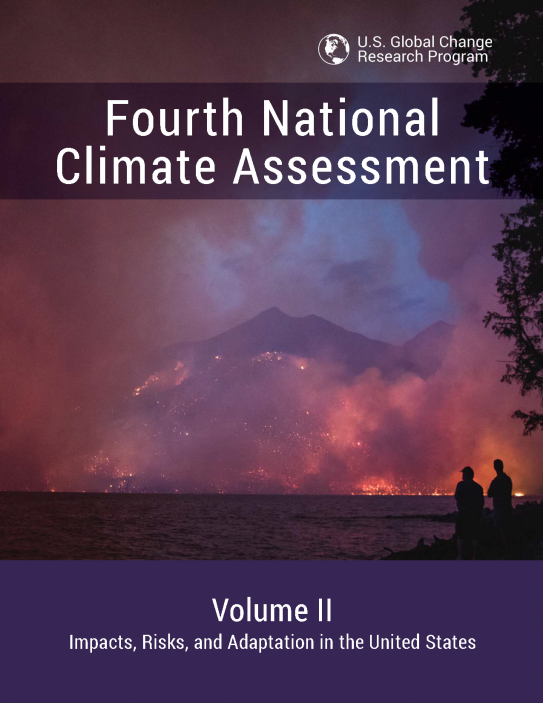Oregon Climate Experts Help Shape New National Climate Assessment
Last week, the U.S. Global Change Research Program released volume two of the Fourth National Climate Assessment. The technical, scientific report assesses the impacts of climate change on the United States – from how climate change will affect different people and regions across the country, to how the country is adapting to effects already underway.
Lesley Jantarasami, a Senior Policy Analyst at the Oregon Department of Energy, served on the steering committee for the newly-released assessment while employed at the U.S. Environmental Protection Agency. We checked in with her on the report and what it means for Oregon.
When did you first start working on this version of the National Climate Assessment?
I represented EPA on the National Climate Assessment Steering Committee. Part of that committee’s purpose was to provide input on what should be in the report. Our contributions were informed by public involvement. We heard from the general public on what they wanted to see in the final assessment, and we brought forth ideas from our own agencies. The idea was to produce a report that would be comprehensive and useful to decision-makers, different agencies across the federal government, and the country as a whole.
Did the planning for that begin right after the Third National Climate Assessment?
Pretty much. By law, these assessments are produced every four years, and they’re based on scientific research, which is always improving and changing. Plus the draft documents were rigorously peer-reviewed by the National Academies of Sciences, Engineering, and Medicine and others. So the production cycle was fairly long.
What other role did you have in the report?
I was the chapter lead for a section on how climate change can have outsized effects on tribes and Indigenous peoples. I started working on the chapter while at EPA, and then finished the work after I moved to Oregon and started at the Oregon Department of Energy in 2017.
What did you learn while drafting this chapter?
The National Climate Assessment has been published four times, but this is only the second time the NCA has devoted a standalone chapter to tribes and Indigenous peoples. Early on, there was some discussion on whether a separate chapter was needed, or if we could cover effects on tribes in various other chapters. We heard a strong demand for having comprehensive information about tribal climate impacts in one place. It was heartening to hear that people found value in this information and wanted to maintain a focus on the unique ways climate change affects Indigenous peoples.
What’s unique about climate change’s effects on Indigenous peoples?
The risks associated with climate change are often really similar across populations, but the effects on Indigenous peoples can be very different. So much of their cultural heritage, history, and livelihoods are associated with the land where they live and work – and that land is changing because of climate risks. Many Indigenous peoples have cultural connections to natural resources, wildlife, and sacred places that are now facing extreme pressures from climate change and may look very different today than they looked to their ancestors. Throughout the country, we found examples of climate-related disasters that are causing Indigenous communities to consider or actively pursue relocation as an adaptation strategy.
There are also differences in how the effects of climate change are measured by Indigenous populations. Many Indigenous peoples have lived in particular areas for hundreds if not thousands of years, which has contributed to knowledge systems accumulated over generations through direct contact with the environment. These unique systems of observing, monitoring, recording, and communicating contribute to detailed, place-based knowledge about climate change impacts and strategies for adaptation.
Does the report include policy recommendations or solutions?
The National Climate Assessment is meant to be a technical, scientific report, so it doesn’t make policy recommendations or evaluate existing or proposed policies. Instead, it’s designed to be a resource for people working on issues influenced by climate. It’s also a clearinghouse of what’s happening on the ground now, and that includes how climate change is affecting people. My chapter had information about how different tribes are feeling the effects of climate change, but also details on what strategies tribes are using to mitigate and adapt to climate change. For example, the chapter talks about renewable energy as more tribes pursue clean energy and energy independence and resilience, plus all the different resilience activities tribes are taking on as the effects of climate change grow more severe.
What does the NCA mean to Oregon?
The assessment provides details and a national perspective on issues that Oregon-specific reports have quantified and discussed. The report includes special emphasis on different regions of the U.S., and the chapter on the Pacific Northwest features contributions from Oregon climate experts – Emily York, the Climate & Health Program Lead at the Oregon Health Authority, and Phil Mote, Ph.D., and Meghan Dalton, who work at the Oregon Climate Change Research Institute, or OCCRI, at Oregon State University. OSU did a nice write-up on the Northwest chapter, which details some of the effects of climate change on Oregon’s landscape and economy. Other Oregonians contributed, too – my chapter on tribes and Indigenous peoples included contributions from Elizabeth Marino, Ph.D., an assistant professor of anthropology at OSU Cascades in Bend.
The NCA also informs efforts we’re taking on in Oregon to understand and adapt to climate risks and vulnerabilities, both at the state level and within cities and local jurisdictions engaged in climate adaptation planning. Efforts include our state climate assessment, which is developed updated periodically by OCCRI, and a state agency effort to update the Oregon climate adaptation framework from 2010, plus other studies and programs coming down the pike.
Read more about the National Climate Assessment and the effects of climate change on Oregon.

